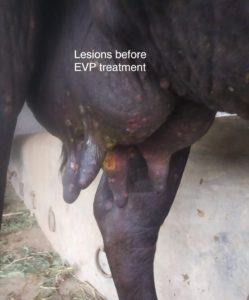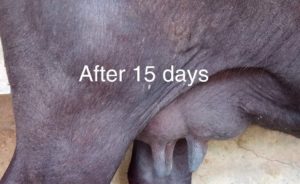Successful treatment of buffalo pox like lesions: Name of Farmer: Mrs. Roja Rani Kore Address: Budda Varam Village, District: Krishna, Gannavaram Mandal., Andhra Pradesh Animal ailment history: • Graded Murrah • Calved thrice, last calving 6 months before • Milk Yield – 10 liters per day • Suffering from buffalo pox like lesions Medicines provided before use of traditional
 formulations: On 15th June, 2019, Shri Suryadevara Srinivasa Rao, the caretaker of the buffalo observed small pustules on one quarter. The buffalo was uneasy during milking. They contacted the local veterinarian for treatment. The veterinarian from the nearby dispensary treated the buffalo with antihistaminic and NSAID for three days. He also gave a single dose of Ivermectin. However, in subsequent days, the infection spread from one quarter to all the four quarters and, there was blister formation and eruption. As a result, the milk production was reduced by 2-3 liters per day. Then Shri Rao contacted a paravet, Sri. Yogendra Prasad, Krishna Milk Union (KMU) who in turn informed Dr. D. Prasad, consultant (AH) and I/c of the NDDB’s Mastitis Control Popularisation Project (MCPP) for treating the buffalo with herbal remedies. Dr. Prasad sent Dr. A. Krishna for demonstration on preparation and application of herbal paste. Shri Rao started applying the herbal formulation 4-5 times a day on the affected parts. It took 7 days for disappearance of the lesions. The calf of the buffalo, which was also affected with the same lesions on the nostrils, also recovered after application of the herbal paste. Materials required for preparation of herbal formulation: Garlic-5 pearls; Turmeric powder- 10 g;; Cumin seeds-15 g; Sweet basil– 1 handful; Neem leaves– 1 handful; Butter -50 g. Cumin seeds need to be soaked in water for 15 minutes and then blended with the other ingredients to a fine paste. Butter is to be mixed with the paste. (click the below link for the detailed treatment protocol: https://www.youtube.com/watch?v=Kk8pgfLYoF4). Cost involvement in EVP – all the materials was available from farmers home. Therefore, there was no money required to be spent by the farmer.
formulations: On 15th June, 2019, Shri Suryadevara Srinivasa Rao, the caretaker of the buffalo observed small pustules on one quarter. The buffalo was uneasy during milking. They contacted the local veterinarian for treatment. The veterinarian from the nearby dispensary treated the buffalo with antihistaminic and NSAID for three days. He also gave a single dose of Ivermectin. However, in subsequent days, the infection spread from one quarter to all the four quarters and, there was blister formation and eruption. As a result, the milk production was reduced by 2-3 liters per day. Then Shri Rao contacted a paravet, Sri. Yogendra Prasad, Krishna Milk Union (KMU) who in turn informed Dr. D. Prasad, consultant (AH) and I/c of the NDDB’s Mastitis Control Popularisation Project (MCPP) for treating the buffalo with herbal remedies. Dr. Prasad sent Dr. A. Krishna for demonstration on preparation and application of herbal paste. Shri Rao started applying the herbal formulation 4-5 times a day on the affected parts. It took 7 days for disappearance of the lesions. The calf of the buffalo, which was also affected with the same lesions on the nostrils, also recovered after application of the herbal paste. Materials required for preparation of herbal formulation: Garlic-5 pearls; Turmeric powder- 10 g;; Cumin seeds-15 g; Sweet basil– 1 handful; Neem leaves– 1 handful; Butter -50 g. Cumin seeds need to be soaked in water for 15 minutes and then blended with the other ingredients to a fine paste. Butter is to be mixed with the paste. (click the below link for the detailed treatment protocol: https://www.youtube.com/watch?v=Kk8pgfLYoF4). Cost involvement in EVP – all the materials was available from farmers home. Therefore, there was no money required to be spent by the farmer.




